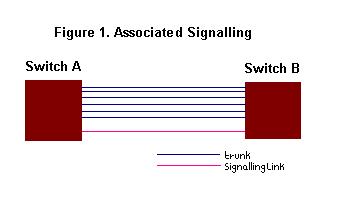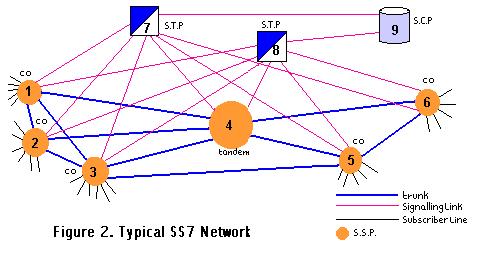
Signalling is the transfer of information between communication components necessary to provide a service and maintain it. We come across signalling as a matter of routine on the telephone network - the dial tone, the digits we dial and the call waiting tone are all instances of signalling between the subscriber and the exchange. All the above are examples of what is termed in-band signalling. Signalling information ( dialled digits ) is sent on the pair of wires to the exchange. We hear the ring tone from the remote exchange, which is signalling too, and then when the call is established, we use the same pair of wires to talk to the other person. This is in - band signalling, because the same trunk ( inter - exchange connection ) which carried the signalling information would eventually carry the call. SS7 is a signalling system used by entities in the telephone network to exchange signalling information. SS7 is, most importantly, out - of - band and characterized by packet data. Out-of-band signalling uses an exclusive channel for exchange of signalling information. Take two telephone exchanges connected to each other through multiple trunks and a signalling link. When a call is made, the telephone exchange, from where the call originates, sends a message over the signalling link asking the called exchange to connect a call to a subscriber. The calling exchange, using the signalling link, tells the other exchange that the call is coming over a particular trunk. The receiving exchange connects the subscriber to the incoming trunk and a circuit is established.
The sequence of events in a nutshell is?..
#1. Subscriber 491-6264 dials 245-0942.
#2. Exchange 491 sends a message to exchange 245 saying "I'm connecting a call from 491-6264 to 245-0942. The call is coming on trunk 27."
#3. Exchange 245 makes sure the called subscriber is free; initiates ringing, opens trunk 27 and generates a ring tone ( in - band signalling ) which the calling subscriber hears.
#4. Subscriber 245-0942 answers and trunk 27 is used for the duration of the conversation.
#5. At the end of the call ( when 491-6264 hangs up ), exchange 491 sends a message to exchange 245 asking it to close the call on trunk 27. Exchange 245 does so and subscriber 245-0942 is sent a busy tone. Trunk 27 is now free for other calls.
All the messages that the exchanges sent to each other were signalling messages that were sent over the signalling link. Out-of-band signalling has distinct advantages over in-band signalling?..
· Signalling can be done anytime during the duration of the call and not just at the beginning.
· Out-of-band signalling, being digital, is faster than in-band signalling techniques such as multifrequency tones.
In general, one of the many trunks between interconnected exchanges are made signalling links. All signalling information between the 2 exchanges goes over this link. But this is perfect as long as the only signalling requirement would be to indicate call setup and teardown, and the 2 exchanges have a direct connection. This is associated signalling.

If the exchanges wanting to establish a circuit have no direct signalling connection, the equation changes perceptibly, and brings in the concept of network signalling. Today's SS7 networks have the 3 following components?..
· signal switching points ( SSPs ) : these are SS7-capable telephone exchanges which originate, switch and terminate calls.
· signal transfer points ( STPs ) : Packet switches of the SS7 network which also perform routing functions.
· signal control points ( SCPs ) : Databases that support advanced call - processing functions.

1, 2, 3, 5 and 6 are typical subscriber exchanges. They are all Stored Program Control SS7 - capable exchanges. 4 is a tandem or trunk automatic exchange that connects two exchanges which might not have a direct trunk between them. 7 and 8 are STPs that allow exchanges to send and receive signalling information from each other. 9 is an SCP that supports advanced call - related features.
Listed below is the sequence of events that establishes a call from a subscriber in exchange 3 to a subscriber in exchange 5.
For more on Signalling System 7, follow the links given below.....
WebProforum Tutorial on SS7 - very well explained. A 'must see' for everyone !
The SS7 Blue Book - This is the original tutorial published by Modaressi and Skoog in the IEEE Communications and the pdf version is available online.
manisridhar at hotmail dot com